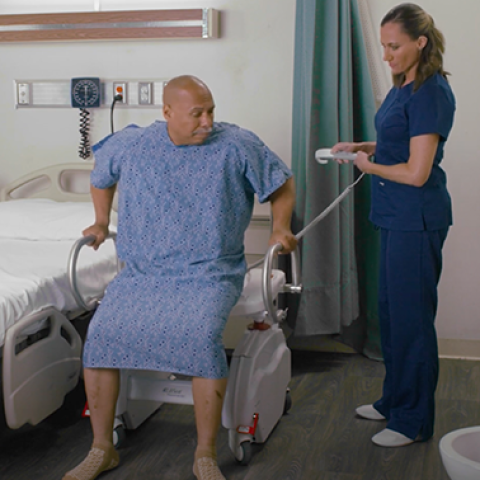Preventing Falls: The Role of Power Toilet Lifts in Hospital Facilities
10/30/2023
Of all preventable adverse events in hospitals, falls are the most common.1 They are also expensive, with an average total cost of $62,521 according to new data published this year.1 About 1 in 3 hospital falls occur while patients are attempting to use the bathroom, making toileting one of the riskiest activities for patients.2
Power toilet lifts, which mimic the natural sit-to-stand motion, can help patients use the toilet more safely, minimizing the risk of toileting related falls and caregiver injury. At a fraction of what an average fall costs the hospital system, power toilet lifts should be considered as part of safe patient handling and fall prevention programs, to not only support the highest level of patient care, but also reduce fall-related costs.
Risk Factors for Toileting Falls
Identifying patients at a greater risk of falls is the first step in developing a toileting-related fall-prevention plan. A 2-year study looking at hospitalized older adults identified several correlations between cognitive and physical impairments and a greater likelihood of falling while using the toilet. Identified risk factors include: “cognitive impairment, urinary incontinence, gait instability, and visual impairment”.3
The study also found that toilet-related falls were more likely to occur overnight/in the early morning hours than other types of falls, and that people who fell during toileting we more likely to fall again.3
Role of Power Toilet Lifts in Fall Prevention
Power toilet lifts address many of the common causes of toileting-related falls. By providing full support during the sitting and standing process, these lifts minimize lower body muscle strain and allow patients who are mobile to more safely use the bathroom with minimal assistance, or in some cases independently.
Staff may not always be available to assist patients needing to the use the bathroom, especially overnight. Even when a staff member is available to assist, many patients will not ask for help. Making a power toilet-lift available for use, especially one that can be used bedside, can provide the support patients need to minimize their chance of falling.
How Power Toilet Lifts Fit into a Healthcare Setting
No adjustments need to be made to bathroom facilities to use a power toilet lift. LiftSeat, who has been making toilet lifts for both home and healthcare use for over 15 years, offers several different models that fit easily in most bathroom spaces by sliding over the existing toilet.
Mobility is another important feature for maximizing power toilet lift utility in a hospital setting. Most hospital facilities do not need a toilet lift for every bathroom. LiftSeat models are all mobile and can be easily unlocked and wheeled between rooms to prioritize assisting with the toileting needs of high fall-risk patients. They can also be quickly converted into a commode for bedside use, further minimizing toileting-related fall risk.
ROI of a Power Toilet Lift
The average cost for an in-hospital fall can range widely. However, even the low-end fall cost is far greater than the cost of power toilet lift. If looking at the high end of the range, that estimates the average fall cost to be over $62,000, a hospital could invest in 10 power toilet lifts for less than the cost of a single fall.
In addition to reducing fall risk, power toilet lifts also help to minimize injury risk to staff. Power toilet lifts remove much of the physical strain endured during traditional toilet transfers, for both the patient and assisting staff member. In many cases, a staff member may not need to assist at all. By preventing a single staff member from injury, a power toilet lift can easily pay for itself 15 times over.4
Bottom Line – Power Toilet Lifts Make Sense
In terms of providing the highest-quality patient care, protecting patients and staff from injury, and bolstering the bottom line, a power toilet lift makes sense. Integrating power toilet lifts into fall prevention and safe patient handling programs can save hospitals hundreds of thousands of dollars in staff injury and fall-related costs, year after year.
LiftSeat manufactures several different models of power toilet lifts designed exclusively to meet the rigorous needs of healthcare facilities. Meeting the requirements for safe patient handling programs, all LiftSeat models offer the flexibility to be used when and where they’re needed to reduce fall and injury risk. LiftSeat also can accommodate patients up to 750 pounds, making them one of the only lifts suitable for use in bariatric settings.
Learn more about the ROI of LiftSeat power toilet lifts in healthcare in this white paper.
References:
- Dykes, P. C., Curtin-Bowen, M., Lipsitz, S., Franz, C., Adelman, J., Adkison, L., Bogaisky, M., Carroll, D., Carter, E., Herlihy, L., Lindros, M. E., Ryan, V., Scanlan, M., Walsh, M. A., Wien, M., & Bates, D. W. (2023). Cost of Inpatient Falls and Cost-Benefit Analysis of Implementation of an Evidence-Based Fall Prevention Program. JAMA health forum, 4(1), e225125. https://doi.org/10.1001/jamahealthforum.2022.5125
- Rose, G., Decalf, V., Everaert, K., & Bower, W. F. (2020). Toileting-related falls at night in hospitalised patients: The role of nocturia. Australasian journal on ageing, 39(1), e70–e76. https://doi.org/10.1111/ajag.12696
- Zou, M., Lu, R., Jiang, Y., Liu, P., Tian, B., Liang, Y., Wang, X., & Jiang, L. (2023). Association between toileting and falls in older adults admitted to the emergency department and hospitalised: a cross-sectional study. BMJ open, 13(6), e065544. https://doi.org/10.1136/bmjopen-2022-065544
- Monaghan, Heather. (2012). Identifying a Return on Investment (ROI) by Introducing the LiftSeat® Toilet Transfer Solution into a Falls Prevention and/or Safe Patient Handling Program [White Paper]. LiftSeat Corporation. https://www.liftseat.com/sites/default/files/Clinical%20Library/ROI-of-LiftSeat-In-Falls-Prevention-Safe-Patient-Handling-Programs.pdf
This content is not intended to be a substitute for professional medical advice, diagnosis, or treatment. Always seek the advice of your physician or other qualified health provider with any questions you may have regarding a medical condition.